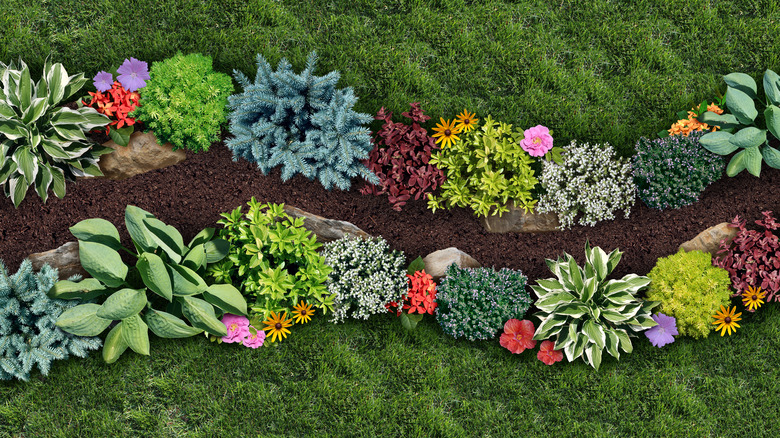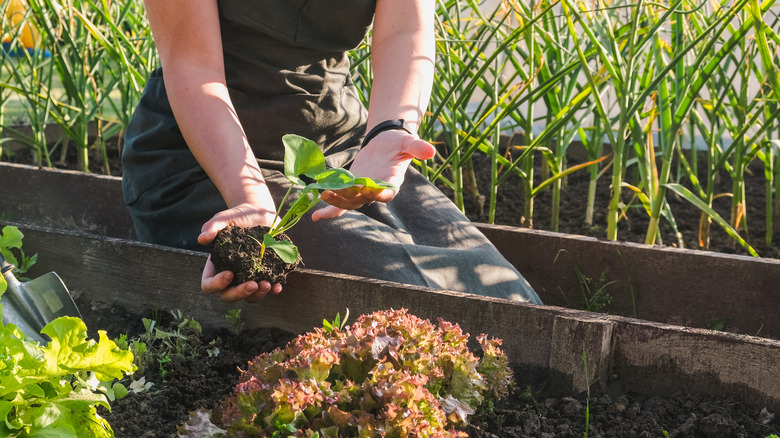What You Need To Know About Dividing Perennials
Perennials are garden favorites for many reasons, especially since they resurface yearly. According to American Meadows, they require less maintenance and effort than annuals (aside from regular weeding) to help them flourish. In addition, they're budget-friendly because you purchase them once, and their blooms fill your garden for years to come. In the first year of planting a perennial, says American Meadows, you may not see any blooms because this is the period they use to build a root system, but the following years should yield flowers.
Once they are established, you can break them up and spread them out because, over time, perennials become overcrowded, leading to competition for nutrients and water, which means they are prone to diseases. Dividing them into smaller sections will reduce these issues as well as stimulate new growth while allowing better control of their growth rates and increasing the total number of plants in your garden.
When is the best time to divide perennials?
First, it's important to plan on dividing them when they're not flowering, so you want to pay attention to your plants' blooming schedule. This way, they can expend their energy on rebuilding leaves and roots. Blooming Secrets says that only healthy plants should be divided; if the root system isn't healthy, the newly divided plant isn't likely to survive. Make sure the soil is well-moistened the day before dividing and that there won't be a lot of sun exposure on the day you do the work. In fact, a rainy period works great to keep the freshly divided plants moist and happy.
Blooming Secrets also advises that springtime is when fall blooming plants should be divided, and those that bloom in spring should wait to be separated in the fall. If you live in a colder climate, make sure your fall-divided varieties are split a month to six weeks before the ground freezes, so they have time to establish roots again. Although ideally, those are the best rules to follow for propagation, according to Rural Sprout, plants can actually be divided at any time they are not in an active growth phase. There are various ways and techniques to separate perennials from the parent plant. Simply put, depending on the kind of plant, either uproot the whole thing or break apart the root with a spade and remove only part of it.
How to successfully divide perennials
Rural Sprout says that varieties needing complete uprooting are smaller with fibrous roots (think hostas). When uprooting, take care to gently excise the plant from the ground, brushing off excess dirt and using your fingers to separate the roots, keeping any leaves intact and replanting quickly. Be sure to water it once you've replanted it.
According to Rural Sprout, larger plants with more fibrous, fleshy, or woody roots may take more work to break apart. Plants like daylilies may require splitting with utensils like forks, knives, or other sharp gardening tools, leaving three to five good root shoots to encourage healthy growth once replanted. Some varieties will need to be divided with a spade, removing only part of the root clump.
Once separated, remove the cutting from the ground and fill the void with soil so the parent plant can quickly recover. Next, you should trim off the large leaves on the cultivar's top, and cut the crown for further division, advises Rural Sprout. These offshoots can be overwintered for next spring or replanted directly into the ground right away.
Plantlets and suckers (some berry plants) can be quickly removed wholly from the ground and replanted, but runners (think strawberries) should remain attached to the main plant until a white root shoot is visible. Even then, keep them bound to the parent and stretch them to a more suitable space within reach to encourage rooting that allows for better growth without crowding.


